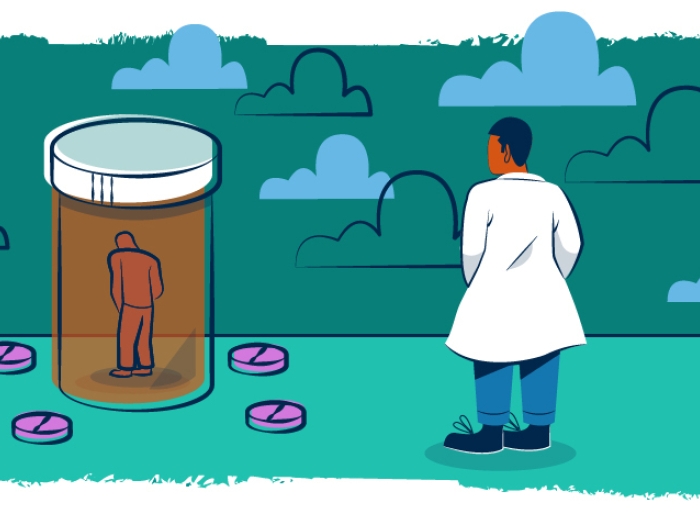Primary care’s role in managing COVID-19 patients, and the rapid evolution of telehealth, sets the stage for a different future.
10:29 AM
Author |

Two years ago this month, the medical professionals who take care of most Americans' health needs had no idea what kind of onslaught was about to hit them.
But today, 78 million cases of COVID-19 later, primary care providers have played a critical but under-recognized role in helping their patients get through the pandemic.
They haven't gotten as much attention as the infectious disease, critical care, emergency medicine and other specialized health professionals who have cared for the sickest COVID-19 patients in hospitals nationwide.
But primary care teams are the ones working to keep as many patients as possible from needing a hospital bed or a trip to the emergency department. And as soon as hospitalized patients are recovered enough to leave, most have come back into the care of the physician and team they've seen for years.
Now, as the COVID-19 pandemic enters a lull across most of the United States, the anniversary of its first few weeks happens to fall during an annual celebration of one type of primary care provider: the general internal medicine physician.
Doctors who specialize in not specializing
Originally designed to showcase this career choice to future physicians, this year the Proud to be General Internal Medicine week offers a chance to look back at how the pandemic rapidly transformed primary care – and how those changes might endure.
Allison Ruff, M.D., who helped organize Michigan Medicine's annual event, , is one of more than 140 general medicine physicians who lead the outpatient care of hundreds of thousands of patients through the Division of General Medicine in the Department of Internal Medicine. Another 130-plus general medicine physicians work as hospitalists, focusing on providing general care for patients in multiple U-M and VA hospital units in the Division of Hospital Medicine.
"We are generalists, specializing in not specializing," she said. "And because of that, we shifted what we do to fill the gaps during the pandemic. That's part of our job by its very nature: when a new disease or phenomenon comes along, we own it through our outpatient care and our role in hospital-based general medicine."
As care and prevention have evolved during the pandemic, said Ruff's colleague Aaron Parzuchowski, M.D., primary care providers, including general medicine physicians, have had to keep pace with rapid change.
A change in approach to care
The overnight shift to seeing general-care patients via telemedicine connection starting in March 2020 relied on the can-do spirit and technical knowhow of many, Ruff noted.
Even when they didn't know if they could get reimbursed by insurance companies for the care they were providing through phone or video chat, primary care physicians knew they had to keep their regular patients on track with managing their chronic conditions – from diabetes to depression to high blood pressure – without coming to the clinic.
At Michigan Medicine and other health systems that train new physicians, they also used telehealth to involve medical students in patient care without requiring in-person presence during times of high risk.
Those virtual visits have now become a normal part of care, with many primary care providers "seeing" their patients through video chat or communicating through messages in the patient portal rather having an in-person visit.
Now that patients and providers have gotten used to this kind of virtual care, it's up to primary care clinics to optimize their use through research like work happening at the U-M Institute for Healthcare Policy and Innovation.
That includes focusing on issues of equity to ensure that primary care telehealth reaches people who aren't already using it because of device or internet availability, Ruff says. It also means offering telehealth to those with the most trouble getting to in-person visits because of work or family responsibilities, transportation challenges and more.
At the same time that they pivoted to telehealth, primary care providers recognized from the earliest days of the pandemic that patients who developed COVID-19 needed in-person care in locations separate away from other patients.
That spurred the rapid creation of Sick Clinics at each of Michigan Medicine's health centers that offer primary care. Each has a separate entrance and exam rooms, and dedicated teams. Those clinics, which ramped up when PCR testing for COVID-19 was incredibly scarce and reserved mainly for hospitalized patients, continue today.
Now, they help prioritize timely care for patients who need timely attention for COVID-like symptoms – including those who have risk factors for severe COVID-19 that might mean they qualify to receive monoclonal antibody treatments or new antiviral medications.
These treatments, if given in the first days of symptoms, can make the difference between a mild and severe case of COVID-19.
Even before such treatments were available, Ruff said, "Primary care providers have formed the backbone of the effort to decompress hospitals during the pandemic, both through efforts on the outpatient side and on the hospitalist side, working to discharge COVID-19 inpatients safely and trusting that their primary care providers can handle their post-hospital care."
The COVID-19 Completion at Home initiative at Michigan Medicine, and similar efforts at the VA Ann Arbor Healthcare System, have helped make that possible. They launched a few months into the pandemic.
By sending COVID-19 inpatients home with a kit of devices to monitor their vital signs and beam the data back to a central intake site, these "hospital at home" initiatives have popped up at major medical centers nationwide. They have made it possible to return patients to the comfort of home and free up crucial hospital beds while keeping tabs on their condition more closely than with other conditions in the past, Ruff said. Home visits by nurses and other providers are critical for some patients.
Even after the initial recovery is over, primary care providers have found themselves on the forefront of another aspect of the pandemic: helping people suffering from the long-term effects of a coronavirus infection. Patients with signs of what's commonly called "long COVID" often report them to their primary care provider. It's up to those providers to ensure patients get referred to specialized clinics like Michigan Medicine's Post-COVID-19 Clinic.
Vaccination against COVID-19 is one aspect of the pandemic that largely hasn't happened in primary care clinics, because of a national decision to focus on vaccination clinics run by pharmacies and public-health agencies.
But even if the shots aren't being given in their clinics, primary care providers have played a pivotal role in helping their patients understand why they should get vaccinated and boosted.
Parzuchowski said this has gotten more and more challenging – and even more important – as time has gone on and providers work to inform the minority of adults who aren't vaccinated.
"I don't think any of us anticipated how hesitant many would be," he said. "We sometimes have to wade into politics and political beliefs with patients for the first time, and build on the trust that they have in us as their regular provider. And sometimes it's just a matter of making the simple recommendation when a person who isn't yet vaccinated comes to see you for another reason."
Ruff recalls one patient who was so nervous about getting vaccinated against COVID-19 that she called Ruff's clinic from the parking lot of the pharmacy where she was scheduled to get her first dose.
"The call center put her through to me, and I stayed with her on the phone while she did it. It felt great to be that person of support, that trusted person," she said.
Staying on top of misinformation and false claims about the COVID-19 and the vaccines against it has become part of the job for many primary care providers, Ruff adds. That's the only way to ensure that they're ready to address a concern or question a patient might bring up, or a request for a particular drug or supplement they might make.
As the new generation of future general internal medicine physicians and other primary care providers comes up, Ruff says the flexibility and innovation shown during the pandemic years showcases why these professions can be so rewarding. And the chance to help turn the lessons of the pandemic into long-term change in primary care is ripe for those who choose to "specialize in not specializing."
Like Podcasts? Add the Michigan Medicine News Break on iTunes, Google Podcasts or anywhere you listen to podcasts

Explore a variety of healthcare news & stories by visiting the Health Lab home page for more articles.

Department of Communication at Michigan Medicine
Want top health & research news weekly? Sign up for Health Lab’s newsletters today!





